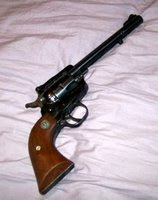 One probably can't think of the Old West without having the image of a six gun in their head.
One probably can't think of the Old West without having the image of a six gun in their head.In addition to being interested in the Old West, I also have a real thing about revolvers and I own several. In fact, the Ruger Single Six that you see here is mine. It fires a standard .22 Long Rifle cartridge and though it is far from a toy, it is largely just a little plinker that is just a lot of fun to shoot.
I also own an 1851 .44 Colt Navy that is quite a lot different from the Ruger you see here. In the first place, it's a black powder weapon which means that it relies on a percussion cap, a lead ball and a measured charge of black powder to do its thing. Also, unlike the Ruger in the photo, it's not a little plinker. In fact, the first time I ever fired it, I immediately stopped to make sure that I had a right hand left because it made one hell of a big boom. All in all, it's a totally different experience from firing a modern firearm. Contrary to what one sees in Western films, most people in the Old West actually used black powder revolvers and many gunmen, such as Jesse James, used the 1851 Colt Navy to do their business simply because a large number of them were left over from the Civil War.
Another thing that you see in films that's not exactly accurate is how many shots a gunman typically fired.
Most of us really make fun of old Westerns that involve shoot-outs where people seem to have limitless supplies of ammunition loaded in their gun. But what you probably don't know, is that despite being often called "Six Shooters" (so-called because MOST revolvers have six chambers), most people actually only kept five of the cylinder chambers loaded and to be safe kept the hammer of the gun on an empty. Needless to say, when they drew their sixer from their holster, they would have to cock it so that a primed chamber moved into line with the hammer.
The reason is, these old guns are actually pretty damn dangerous. In addition to having a charge of gunpowder in each cylinder chamber, each one also has a percussion cap that fits onto a nipple behind the charge of gunpowder. When you pull the trigger, it slams onto the percussion cap, which sets off a charge that ignites the gunpowder, the force of the explosion which propells the ball out of the barrel. It's a pretty simple concept, but unlike modern guns, these old relics are a bit unreliable, not to mention unpredictable. In addition to sometimes chain firing (where the ignition of the percussion cap or powder accidentily sets off an additional chamber - that's not a good experience), the caps themselves can be set off by even a small blow, which in turn sets that chamber off. (Believe it or not, the first person who lost their life on the Oregon Trail wasn't killed by Indians, nor did they die of some dreaded disease. Instead, the guy accidentily shot himself while taking a loaded rifle out of a wagon).
Wyatt Earp (who was perhaps not always so handy with a six gun, afterall) quite often carried his revolver with all six chambers loaded in his younger years. That is, until one day, he sat down in a chair in some saloon and his un-thonged gun fell out of its holster, hit the floor and promptly discharged. The resulting shot whizzed past his head and buried itself into the ceiling above him. Following that experience, Earp always kept that sixth chamber empty.
So needless to say, the next time you watch a Western and you see some guy take six shots with his revolver, just remember that he's likely a tinhorn with a deathwish.




No comments:
Post a Comment